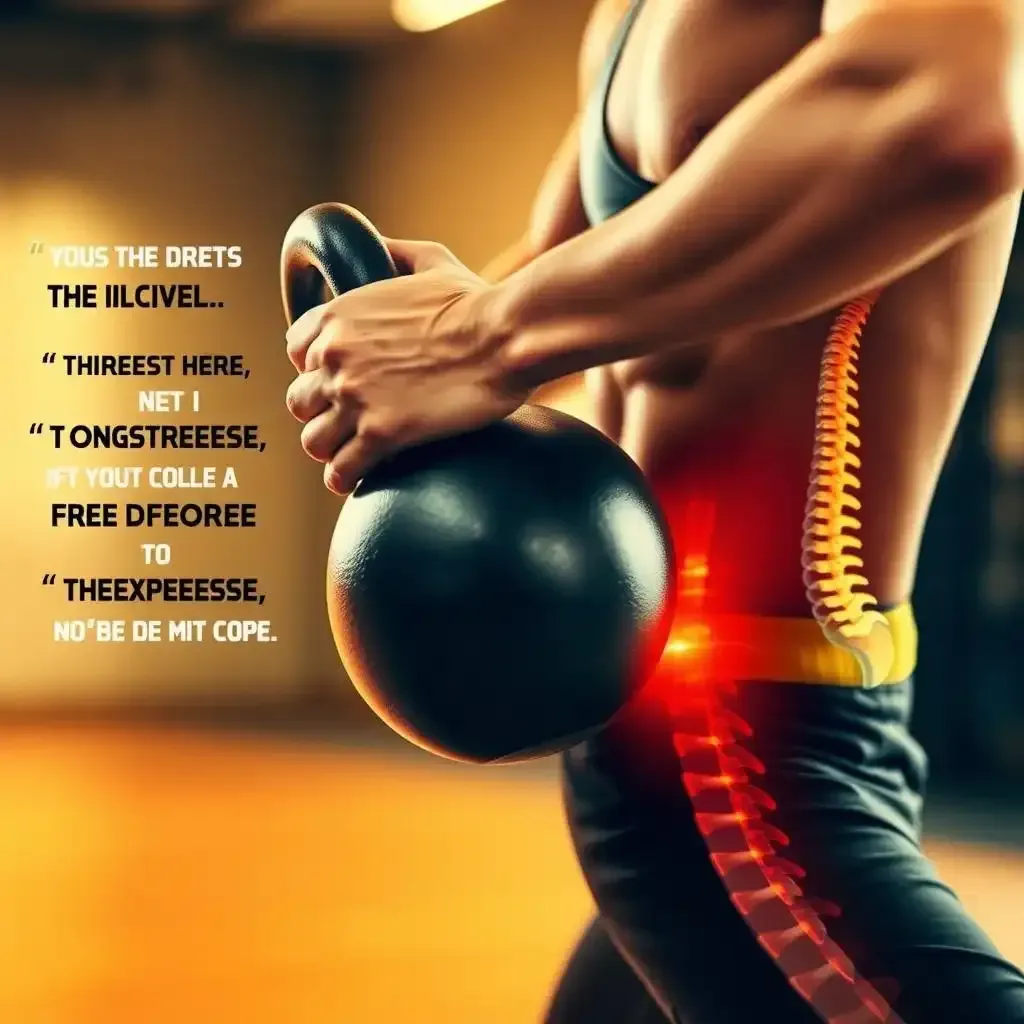Table of Contents
Are you tired of the same old crunches and sit-ups? It's time to level up your core game with kettlebell exercises. Kettlebells are not just for building strong arms; they are a powerful tool for sculpting a rock-solid core. At kettlebellworkout.homes, we know the best ways to engage your core and improve your overall strength and stability. In this article, we'll examine into the fundamentals of kettlebell core exercises, explore the top moves, and show you how to integrate them into your fitness routine. Get ready to transform your midsection and take your workouts to the next level.
Kettlebell Core Fundamentals

Kettlebell Core Fundamentals
Understanding Your Core
Hey there, fellow fitness explorer! Let's talk core. It's not just about those six-pack abs you see in magazines. Your core is *everything* – your back, abs, hips, and even your glutes all work together like a superhero team. Think of it as your body's ability center, keeping you balanced, stable, and strong enough to lift that heavy kettlebell (or your kid, if they're feeling extra clingy!). A strong core prevents injuries – no one wants a backache stopping them from playing their favorite video game. Kettlebells are awesome because they challenge your core in ways regular crunches never could. They make you work harder, and that’s good!
For example, imagine trying to balance on one leg. That's your core working overtime to keep you upright. Now imagine doing that while holding a kettlebell. It's like upping the difficulty level in your favorite video game, right? That increased challenge is what builds strength and stability. Kettlebell exercises force your core to do double duty – it's not just about flexing your muscles; it's about controlling your body's movement. And that control is key to preventing those annoying injuries.
- Improved posture
- Increased strength
- Reduced back pain
Mastering Proper Form
Okay, so you've got your kettlebell, you're pumped, ready to go. Hold on a sec! Before you start flinging that weight around like a pro wrestler, let's talk about form. Proper form is like having a cheat code for your workout – it maximizes results and minimizes the risk of hurting yourself. Think of your body as a finely tuned machine; bad form is like throwing sand in the gears. You need to engage your core properly to prevent injuries.
This is where things get a little technical, but bear with me! Imagine your core as a tight corset, supporting your spine. Every kettlebell movement should start with this core engagement. It’s like a secret weapon that makes the exercise much more effective. It's not about how much weight you lift; it's about how well you control the weight. Need some guidance on form? Check out our kettlebell form guide for a visual step-by-step!
"Form before weight, always." - Unknown Kettlebell Guru
Choosing the Right Kettlebell Weight
Don’t go crazy with the weight right away! Starting with a lighter kettlebell is crucial. It's tempting to jump straight into the heaviest one, thinking you'll get faster results. But that's a recipe for disaster! It's like trying to run a marathon before you can even jog around the block. It's all about building a solid foundation and gradually increasing the weight as you get stronger.
Think of it as a video game – you start at level one, mastering the basics before moving to harder levels. Start light, focus on perfect form, and gradually increase weight as you get stronger. This way, you build strength steadily, making sure you avoid injuries. Don't be afraid to ask for help at your local gym – trainers can advise you on the right weight and correct form. Need help picking the right weight? Check out our kettlebell weight guide for helpful tips!
Weight | Recommended for |
|---|---|
8kg (18lbs) | Beginners |
12kg (26lbs) | Intermediate |
16kg (35lbs) | Advanced |
Top Kettlebell Exercises for Core Strength

Top Kettlebell Exercises For Core Strength
Kettlebell Swings: The King of Core Exercises
Okay, let's talk kettlebell swings. They're like the ultimate core workout disguised as a full-body blast. I'm not kidding; it's amazing how much your core screams during these. It's not just about the swing itself; it's about the *control*. You're not just heaving the kettlebell; you're using your core muscles to propel it upwards, and then to control its descent. It's like being a conductor of an orchestra – you're leading the movement, coordinating your muscles to create a powerful and controlled swing. It’s a ballet of strength! Want to see exactly how to do it? Check out our guide on kettlebell exercises for starters.
I remember my first swing attempt – I felt like a newborn giraffe learning to walk, clumsy and uncoordinated. But with practice, I discovered the ability of core engagement. It’s not just about brute strength; it's about that deep core link, that feeling of pulling your belly button towards your spine. The more you practice, the smoother and more powerful your swings become. It's like learning to ride a bike – at first, it's wobbly, but soon you're gliding effortlessly. And believe me, the results are worth it! A strong core improves posture, reduces back pain, and makes everyday activities like carrying groceries or playing with your kids feel easier.
- Focus on hip hinge, not back arch.
- Keep your core tight throughout the movement.
- Control the weight, don't let it control you.
Turkish Get-Ups: A Full-Body Core Challenge
Now, let’s talk about the Turkish Get-Up (TGU). This exercise is a total body workout, seriously! It's like a full-body puzzle, requiring coordination, strength, and balance. It's not just about getting up; it's about the controlled movement. Each step requires core engagement to maintain stability and prevent yourself from collapsing like a deck of cards. I used to think it was impossible, a move only for super-athletes. But trust me, with practice, it becomes easier, and more rewarding. You’ll improve your strength, coordination, and stability all at once. Need a visual guide? Check out our kettlebell basics guide for a step-by-step breakdown.
The TGU is a progression, not a sprint. You'll start slow, focusing on perfect form. It's not about how fast you complete the movement, but how smoothly you control your body throughout. As you get stronger, you'll notice how much easier everyday movements become. My own experience with TGUs was a gradual process. Initially, I struggled with the transition from lying down to sitting up. But with persistent practice and attention to technique, I became much stronger and more stable. It's a testament to the ability of consistent effort and proper form. The feeling of accomplishment after successfully completing a TGU is unmatched. It's a feeling of mastery, a reminder of your own strength and resilience.
Exercise | Primary Muscles Worked | Core Engagement Level |
|---|---|---|
Kettlebell Swing | Glutes, Hamstrings, Core | High |
Turkish Get-Up | Full Body, Core | Very High |
How to Incorporate Kettlebell Core Exercises into Your Workout

How To Incorporate Kettlebell Core Exercises Into Your Workout
So, you're ready to rock those kettlebell core exercises, huh? Awesome! But don't just throw them into your routine willy-nilly. Think of it like building a Lego castle – you wouldn't just dump all the bricks on the floor and hope for the best, would you? You need a plan! First, assess your current fitness level. Are you a total newbie or a seasoned workout warrior? Starting with a beginner routine is key, even if you think you’re super fit. Trust me, it’s better to ease in than to hurt yourself and have to take a break. For some great starting points, check out our beginner kettlebell routines.
Next, pick 2-3 kettlebell core exercises that you like. Don't try to do everything at once. It's like learning a new video game – you wouldn't try to master every level on day one, right? Focus on mastering the basics first! Then, integrate those exercises into your existing workout routine. If you already have a strength training day, add the kettlebell exercises to that. If you're more of a cardio bunny, try adding a few kettlebell exercises as a warm-up or cool-down. Need some ideas for getting started? Our guide on kettlebell exercises for starters has you covered.
- Start slowly and gradually increase the intensity.
- Listen to your body and rest when needed.
- Focus on proper form to avoid injuries.
Remember, consistency is key! Just like brushing your teeth, you wouldn't skip it every other day, right? Aim for at least 2-3 kettlebell core workouts per week. But don't overdo it! Overtraining is a real thing, and it can lead to injuries and burnout. It’s like playing your favorite video game for 12 hours straight – you’ll get tired and probably not have as much fun. Find a balance that works for you and stick with it. Don't forget to rest and recover, too! Check out our kettlebell workout tips for more advice on creating a balanced routine.
And finally, make it fun! If you dread your workouts, you're less likely to stick with them. Find exercises you enjoy, put on some music you love, and make it a party! Try different exercises, explore variations, and find what works best for your body. If you’re looking for some fun ideas, check out our easy kettlebell exercises. Remember, a strong core is a happy core, and a happy core helps you lift heavier things, do more cool stuff, and feel great about yourself. Think of it as leveling up in the game of life!
Day | Workout | Rest |
|---|---|---|
Monday | Kettlebell Core | Rest |
Tuesday | Cardio | Rest |
Wednesday | Kettlebell Core | Rest |
Thursday | Strength Training | Rest |
Friday | Kettlebell Core | Rest |
Saturday | Active Rest (Yoga, walk, etc.) | Rest |
Sunday | Rest | Rest |
Benefits of Kettlebell Core Exercises

Benefits Of Kettlebell Core Exercises
So, why bother with all these kettlebell exercises? Well, let me tell you, it's not just about getting a six-pack (though that's a nice bonus!). Think of your core as the foundation of your entire body. It's what keeps you balanced, stable, and prevents those pesky injuries we all want to avoid. Kettlebell exercises are amazing because they work your core in ways regular crunches just can't. They challenge your stability, forcing your muscles to work together in a way that builds strength and endurance. It's like building a really strong tower out of LEGOs - you need a solid base to make it tall and sturdy!
For instance, I used to have terrible back pain from sitting at my computer all day. After adding kettlebell swings to my routine, my back pain practically vanished! It wasn't just about the exercise itself; it was about how much stronger my core became. It's like I got a secret upgrade for my body’s stability. Now, I can lift heavier things, play with my kids without hurting my back, and even feel more confident and powerful in my everyday life. Want more tips on building a strong core? Check out our core strengthening guide for more exercises.
- Improved posture – stand taller and feel more confident!
- Increased stability – better balance for all your activities.
- Reduced back pain – say goodbye to those nagging aches.
- Enhanced athletic performance – strength up your workouts.
- Stronger core – feel the difference in everything you do!
But it's not just about the physical benefits. I've found that kettlebell training has boosted my confidence. It's amazing how much better you feel about yourself when you know you're capable of challenging yourself physically. It's like unlocking a new level in a video game – suddenly, you're stronger, more capable, and ready to take on any challenge. It's a great way to build mental toughness as well as physical strength. Need more inspiration? Check out our beginner-friendly guide for simple exercises.
And finally, don't forget the fun factor! Kettlebell training can be super enjoyable. It's a fantastic way to mix things up and keep your workouts interesting. I love the challenge of mastering new exercises and seeing my progress over time. It's like learning a new dance routine – at first, it's challenging, but as you get better, it becomes more fluid and graceful. Think of it as a fun journey that makes you stronger and more confident. Want to make your workouts more exciting? Read our easy exercise guide for some fun ideas!
Benefit | How it helps |
|---|---|
Improved Posture | Stronger core muscles support your spine. |
Increased Stability | Better balance and coordination in daily life. |
Reduced Back Pain | Stronger core muscles protect your back. |
Final Thought
Kettlebell exercises for core strength are not just a trend; they are a proven method for building a strong, stable, and sculpted midsection. By incorporating these exercises into your routine, you'll not only improve your core but also enhance your overall fitness. So, grab a kettlebell and start your process to a stronger you. For more tips and exercises, visit kettlebellworkout.homes and join our community of fitness enthusiasts.